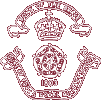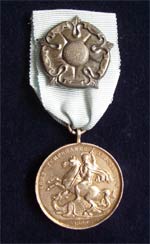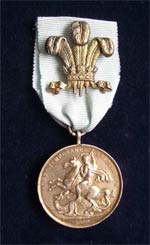


 |
 |
|
 |
||
| Navigation links at the bottom of this page | |||||||
| 1897 Temperance Medal | |||||||
In A Guide to Military Temperance Medals (2001 pub: Stewart Publishing and Printing, Markham, Ontario), David A. Harris provides data on the emblems chosen by the Royal Army Temperance Association (RATA) for use by the Royal Hibernian Military School and the Duke of York's Royal Military School. Notice of the medals was given in the May 1897 issue of the Association's house organ On the March The notice advised that the 'Two silver badges ... could be attached to the centre of the one-year medal ribbon ATAH.2, (Army Temperance Association Home) awarded as follows:' |
|||||||
"The Council give to every boy joining- from the Duke of York's or Hibernian Schools, and who remains a faithful member of the Association and is presented with the first year's Medal, an additional silver badge, to be affixed to the ribbon of the Medal. These Badges will be issued from Head-Quarters of the Association on application by the Branch Secretary" On The March, May 1897." |
|||||||
In a subsequent edition of On the March (June 1902), appeared an illustrated summary of 'Honors awarded for membership' under its banner heading that gave the patron and principal officers of the Association. Although it might strike one as incongruous to award a medal to boys of 14 willing to swear to remain sober for one year, there was a strong relationship between the military schools and the ATA. Annually, the ATA held 'temperance exams' for pupils in all military schools, including garrison and regimental schools as well as the RHMS and DYRMS. The results were usually reported in the On the March journal. For example, the June 1909 issue mentions the following students as gaining Awards: L.J.W. White, S.A. Green, G.P. Robinson, K.H.F. Veasey, F.G. Woolnough (students at DYRMS), W.J. Knott (student at RHMS). The monitors for the exams were Josephine Pugh, Robert C. Watterton, William F. Nugent (RHMS), A. E. Nye (DYRMS). A. E. Nye was none other than Lt. Gen. Sir Archibald Nye, Vice Chief of the Imperial General Staff from 1941-46 who wrote the false letter to General Alexander for the XX Committee in which Operation Mincemeat was conceived to deceive the Germans into believing the force about to invade Sicily during WWII was to attack Sardinia . [Look for an article on Nye in the Voices from the Past page, due for posting shortly.] The movement to promote abstinence among the very young about to enter Royal Navy and the Army was of serious concern at the turn of the 20th Century. This movement, directed by some of the most senior officers of the Army and Royal Navy was directed at all ranks, their families and anyone over whom the military exercised authority. |
|||||||
 |
 |
||||||
| Duke of York's badge adopted by the RATA for use with the one-year ATAH, 2, medal ribbon. | Hibernian School badge adopted by the RATA for use with the one-year ARAH, 2, medal ribbon. | ||||||
Although the Army temperance movement flourished in India and the Home Command at the beginning of the 20th Century it declined over the years and, in the late thirties its affairs were taken over by the Department of Army Chaplaincy. According to David Harris, who kindly supplied the two images of the temperance medals that appear here, the curator of the Museum of Army Chaplaincy found interesting material in storage. This included un-issued examples of the Duke of York rose and the Prince of Wales feathers emblems, which appear on the medals here illustrated. Among the same collection of material found in the Museum storage was the 1899 5th Annual Report of the ATA (the Association was not granted use of the 'Royal' until 1905) an entry appeared under the heading 'School Badges': |
|||||||
| "The Silver Badges for boys who leave the Duke of York's and Royal Hibernian Schools as abstainers, and keep their pledges for one year after joining their Regiments, have been presented by the Council to 26 Duke of York School Boys and 9 Royal Hibernian School Boys." | |||||||
| Harris notes: "The first reference found to the Badges is in 1897, (A Guide to Military Temperance Medals, p. 76) although they may have been approved earlier. A careful reading is needed to avoid the mistaken impression that they were issued by the school. The military schools did not issue the badges, they were issued to boys AFTER they had joined their regiment and abstained for one year, to show that they had attended the school before joining the regiment. Initially, the Badges were attached to the Home one year medal, ATAH.2, though it is possible that if a boy joined a regiment in India they may have been attached to ATAI.2 (Army Temperance Association India). Only after 1905 were 'Royal' one year medals issued, and these would then be the ones to which the badges were attached. (Editor's acknowledgement: The generous help of David Harris in preparing this article is recognized. Copies of his book are available through this site.) |
|||||||
| ||||||||||
|
© A. W. Cockerill 2011 Site Map Contact me | ||||||||||